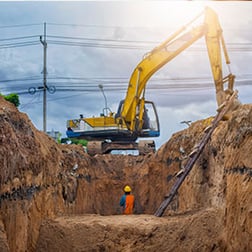One Bridge Solutions
The Advantages of a Centralized Pipeline Data Management System
Integrity teams rely on a wide array of technologies to overlay and analyze smart tool runs, direct assessments, GIS, and more. It isn’t easy to consolidate all this information, but these days—due to new regulations—there’s a growing need for centralized data management. This is particularly challenging for mature pipeline companies that have years of information gathered from multiple sources. This patchwork of oil and gas pipeline data creates many complications:
- Information inaccuracies
- Data duplications
- Workflow inefficiencies
- Inconsistent governance
- Missed opportunities
One of the key barriers slowing the centralized pipeline data management is silos. A clear (and relatable) example of a data silo is an Excel sheet—stored, tracked, and updated solely on an analyst’s computer.
Isolated repositories—data silos—evolve for other reasons too. The most familiar silos are technical—datasets formatted for different software programs.
Problems with data silos in pipe integrity
The more transparency across departments, the better equipped it is to meet business goals. However, every pipeline company has its share of data silos, and, ironically, many evolve from efforts to advance integrity analysis.
Specialized threat analysis tools often have software-specific formatting requirements. That means every time an analyst uses a different tool they must convert the input data. Soon, an operator has a collection of datasets, each with a unique format.
All these independent silos create problems:
Wasted Time – Information silos force business leaders to navigate layers of ILI data to get the details they need. It takes valuable time from both the person requesting info and the staff who manage it.
Inconsistency – The isolated development of silos leads to conflicting records. As teams try to work together, it becomes clear that one source is different than another—which one do you trust? Resolving these disparities is frustrating for both users and decision-makers.
Data Gaps – Due to differences in tools, data gaps can develop over time. Carrying out comprehensive integrity work means finding and validating missing data. Filling omissions is tricky and—even worse—increases the risk of errors.
Today we’re at a point where the legacy tools intended to improve threat analysis have made it more complex. Centralizing oil pipeline data solves these difficulties and creates a foundation for better problem-solving.
Use a centralized pipeline data management system for pipe integrity without barriers
With access to a single source of trusted data, enterprises are well positioned for pipeline integrity work.
OneBridge’s Cognitive Integrity Management (CIM) is an innovative, cloud-based platform that centralizes info from multiple silos. Using CIM, an operator can:
- Leverage powerful machine learning and data science capabilities.
- Align integrity data, even if it’s been transformed to fit legacy software.
- Re-establish correlation between out-of-sync records.
- Identify gaps and quality issues to correct them.
Centralizing integrity info with CIM offers further benefits for your organization.
Eliminate data silos
Accessible, centralized storage lets decision-makers from different teams get the information they need to support everything from creating a dig schedule to long-term capital planning.
It also lets analysts take advantage of the computational power of machine learning and data science. With this technology, the more info the system ingests, the more refined threat analysis algorithms become.
Ensure data accuracy
Bad data costs pipeline companies more than just wasted time resolving issues. It also negatively impacts project spend, compliance, and potentially your company’s reputation. All these things add up. In fact, according to an IBM estimate, poor quality data cost the U.S. economy $3.1 trillion in 2016.
Using a centralized pipeline data management system means the information you access is information you can trust—it’s accurate and authentic. A single source eliminates duplication errors and helps ensure info is always up to date.
This also assists companies in complying with the Mega Rule, which went into effect in 2020. It mandates a comprehensive system of risk-based integrity, repair and validation practices. All operators must deliver clear and auditable records, which CIM functionality can provide.
Reveal the big picture
Without silos slowing things down, integrity teams can quickly identify pipeline threats using info from in-line inspections, SCADA systems, direct assessments, and more. Access to a single, trusted source of data allows engineers to construct a complete picture of pipeline integrity.
Altogether, the advantages of centralized data make a strong business case for shifting information into a unified system. And OneBridge’s CIM software elevates integrity even further. There is no tool available to deal with all the different types of vendor and tool data effectively other than OneBridge.
With CIM, analysts are able to contextualize threats at a single point on their pipeline and smoothly carry out advanced threat analysis. The platform helps decision-makers identify the highest priority threats and confidently defer the issues that can wait.
Are data silos holding your pipeline integrity team back?
Contact OneBridge to learn how our Cognitive Integrity Management software centralizes oil & gas pipeline data, putting information into the hands of those who need it most.


















